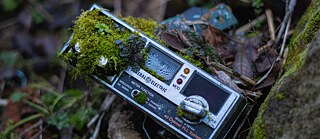Radio in Brazil Essential Component of National Identity

For over 100 years, radio has played an important role in daily life in Brazil, helping to forge important characteristics of the national cultural identity: popular music, radio soap operas, and passion for soccer. The lack of public policies for archiving radio collections is threatening the preservation of the acoustic heritage. Juliana Vaz spoke with Marcelo Kischinhevsky, Professor of Communication and Director of the Centre for Radio and Television at the Universidade Federal do Rio de Janeiro.
There was, in fact, a broadcast in 1922, during the celebration of the centenary of Independence in Rio de Janeiro, which led to the fanciful and mythical narrative that the first official radio broadcast in Brazil occurred at that time. But actually, the pioneering experiments in voice transmission are pre-radio. Since 1910, there have been public demonstrations of technology in Brazil, by the Marconi Company (British telecommunications and engineering company) and Telefunken (Society for Wireless Telegraphy). When Westinghouse came in 1922, that demonstration was made parallel to the centenary celebration of Independence, the president gave a speech, and from that came the narrative that radio started then and there, at the hands of an American company, which is incorrect. In 1919, the Rádio Clube de Pernambuco, for instance, was already making public demonstrations of pre-recorded broadcasts. Today, it is well known that incorrect versions of the early days of radio had been circulating for a long time.
In the early days, radio had an educational slant. It did not have that much commercial appeal, right?
In the 1910s, the first broadcasters to emerge in the United States, in Europe and in Brazil were organized around universities or groups of fans and intellectuals whose intent was to use radio as an educational tool. Of course, the idea of education at the time was mostly based on Enlightenment principles: to pass on culture with a capital “C” to the illiterate population. However, it was only at the end of the 1920s and into the 1930s that radio became popularized and organized as a business. Advertising was only regulated in Brazil in 1932.
Radio has played a significant role in shaping people's cultural coexistence.
Yes, that’s right. In the 1920s, Roquete Pinto, the host of Rádio Sociedade in Rio de Janeiro, would open the newspaper and read the articles that he considered important. He used to say: “Many people do not know how to read or cannot read, because they have some sort of visual impairment or a certain degree of blindness.” This perspective on information has existed since the early days and intensified with the country’s industrialization movement, which accelerated mainly in the 1940s. For the population coming from the countryside to the cities, the radio was a compass, a companion, a way for them to locate themselves within the urban space. Radio was and still is today a central component in the organization of people’s culture. Between 80% and 90% of the population listen to the radio, according to IBGE (Brazilian Institute of Geography and Statistics) data. Although underestimated, radio is an amazing, invisible, portable medium. It is part of people’s everyday life, in their cars, on their portable radios, on their cell phones, on the internet, and on their computers.
People talk a lot about the death of radio, but it always reinvents itself and survives—most recently, for example, with podcasts. Is it possible to say that they are a form of radio?
That is a long discussion, which began in 2005. At first, people said that the podcast was not radio because it did not transmit in real time, its production was decentralized, and its lectures and classes were not radio content. But, in my view, those arguments are very weak. What was radio in the 1920s? Lectures, language classes, and gym classes. And those classes lasted until the 1980s. There were all sorts of content on the radio during that initial phase, and that is true of podcasts as well. Today, I see the podcast as a radio modality, a way of making radio on demand. There is clearly an affinity between the language of the podcast and that of radio. There is obviously a correlation between narrative podcasts, such as The Evandro Case and Beach of Bones, which became very popular in Brazil, and major radio documentaries made during the 1970s and 1980s. Podcasts are practically radio shows with slightly different characteristics—they are not identical, but they are similar to radio plays.
In 2019, only 13% of internet users in Brazil were listening to podcasts. In 2022, that contingent jumped to 31%. Is that trend likely to continue?
During the pandemic, the expectation was that the podcast would suffer, because at the time it was being consumed by people making long commutes on public transportation or in their cars. Without all those people in transit, with people stuck at home, people imagined that podcasts would suffer, but instead, the format exploded, and there was enormous growth in their production. According to data from VoxNest, a company specialising in podcast solutions, Brazil led the growth ranking in the number of podcasts during the pandemic – in the most acute phase, many people even became aware of podcasts. I believe the trend is still on the rise and that the podcast market still has a lot of room for growth in the country. I did a study on presidential candidates’ use of radio and podcasts in the 2022 election. My findings were highly important and rather significant: through cutting edge podcasts like Podpah, Flow, or Mano a Mano, you can talk with millions of people. And there is room for in-depth interviews, which would never exist on traditional radio.
Rádio Nacional reported about the football clubs in Rio.
Radio was also important for airing soccer games, the national passion?
Yes, in Brazil, the games were broadcast mainly by Rádio Nacional. It was dominant at a time when there were no restrictions on transmission power for AM. In its heyday, Rádio Nacional covered 40% of the national territory. Today, an AM station has a range that is limited to a radius of no more than 400 kilometers (almost 250 miles). Rádio Nacional was so powerful that today many people in the Northeast root for Rio de Janeiro’s soccer clubs. Why is that? Because Rádio Nacional was formerly present in people’s daily lives, narrating the accomplishments of Rio’s clubs.
You point to the lack of public policies for preserving radio heritage in Brazil. How does the country deal with its sonic heritage?
We do not have a public policy on memory, and that is a tragedy. Every Brazilian radio station is required to keep the recordings of its programs for 30 days. And what happens? That floor becomes a ceiling. After 30 days, everything is thrown out. In the 1990s, a large commercial radio station in Rio de Janeiro threw out its entire collection of vinyl records. Imagine how many things were thrown away in a drastic gesture such as that, by a manager who had no clue about what he was doing. We have a few collections, some isolated initiatives, but there is no public policy for archiving programming history. We don’t even have a rule regarding how to store it: what codec will be read ten years from now? There should be an agreement on how to store, digitize, and preserve memory.


